#mythos parallel theory
Explore tagged Tumblr posts
Text
What the fuck is Jesus up to in Good Omens season 3?
This is a question I've been thinking long and hard these past couple of days and I have some THOUGHTS SO. Buckle up.
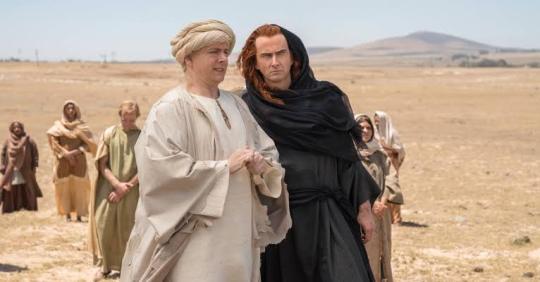
Aziraphale and Crowley watching the Crucifixion (Good Omens, 2019)
First off. The answer to the question posited is relatively simple. What is Jesus up to in GO3? With s2's ending in mind and with the hints we've gotten for 668: Neighbor of the Beast over the years, we know he's descending to Earth to initiate the Second Coming. And that Aziraphale would probably make that happen - or do everything that he can as Supreme Archangel to sabotage it.
But I wanted to examine on how Jesus might fit into Good Omens' overall narratives and established themes - about morality and humanism and free will, and. I'm just saying, there are A LOT of fascinating routes they could do for his character.
(Disclaimer as usual: this is a theory that I obsessed over when I was stuck at the cemetery during All Souls' Day and must be treated as such. In no way am I insisting this should be how canon events must happen. I am just doing this for the funsies.)
The THING about Jesus if you situate him in the world of Good Omens (with the assumption that most of the pop culture Christology mythos associated with him remain intact) is that in this context he very quickly becomes: 1. Adam Young's narrative foil; and 2. an Aziraphale parallel.
Now, the first one is obvious. Of COURSE he is Adam Young's foil, duh. Adam isn't called the ANTICHRIST for nothing. Brought into the world just for the sole purpose of ending it. However, when the time comes for him to fulfill the Will of his Satanic Father, Adam flat out REFUSES.
Both the book and the show attribute this to Adam's human upbringing. He was raised as a human, and because of that he has the trait that the book uses to DEFINE human beings: free will. At the end, Adam had the AGENCY to reject the destiny planned out for him.
'Adam stood smiling at the two of them, a small figure perfectly poised exactly between Heaven and Hell.
Crowley grabbed Aziraphale's arm. "You know what happened?" he hissed excitedly. "He was left alone! He grew up human! He's not Evil Incarnate or Good Incarnate, he's just… a human incarnate—"'
- (Good Omens, 1990)
That is NOT what happened to Jesus.
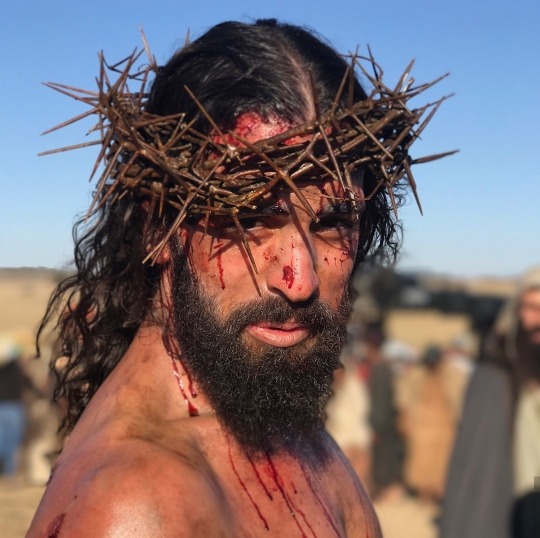
Adam Bond as Jesus in Good Omens (2019)
Like Adam, he was raised as a human -- being a human incarnate was his WHOLE DEAL in Christology. In the beginning was the Word, and the Word was made flesh and dwelt among us... yada yada yada.
UNLIKE, Adam, though, Jesus wasn't able to REJECT his Destiny of Dying Really Horribly and Painfully on the Cross. Narratives in the Bible also made it clear that the Crucifixion was NOT his Will, but that of God's. Like... him begging to be spared from torment but ultimately following God's Will is such an important event entire devotional practices are made out of it.
"39 And he went a little farther, and fell on his face, and prayed, saying, O my Father, if it be possible, let this cup pass from me: nevertheless not as I will, but as thou wilt."
- (Matthew 26: 39, KJV)
We get a glimpse of that in s1ep3 of Good Omens, too:
"JESUS
(muttering through the pain)
Father, please . . . you have to forgive them . . . they don’t know what they are doing . . .
Crowley, in black, comes up next to Aziraphale.
CROWLEY
You’ve come to smirk at the poor bugger, have you?
AZIRAPHALE
Smirk? Me?
CROWLEY
Well, your lot put him on there.
AZIRAPHALE
I am not consulted on policy decisions, Crawley."
- (The Quite Nice and Fairly Accurate Good Omens Script Book, 2018)
SO. Here we have the character of the Christ whose free will and agency had been STRIPPED from him in the guise of a "noble sacrifice." He comes back again on this Earth to fulfill another "inescapable destiny."
Aziraphale and Crowley need to stop him. The solution the Good Omens narrative offers to "inescapable destinies and systems" (both in s1 and s2) is for the character to realize they have the freedom to choose their own fates. It happened with Adam, and it happened with Gabriel, and perhaps it will happen to Jesus.
(At this point my sister frowned and said: "Are you telling me you think Aziraphale and Crowley are going to help Jesus realize he has agency and that him Dying on the Cross for the 'Great Plan' was kinda fucked up actually?" which sounds crazy when you put it like that BUT NEVER SAY NEVER BABIE.)
Because that brings me to my second point: if this all happens, Jesus becomes an AZIRAPHALE parallel.
In the same way Anathema is an Aziraphale parallel and Sergeant Shadwell is an Aziraphale parallel. Here is a character stuck in a suffocating status quo. To save the world, he needs to know he can escape that status quo and decide for himself. In the same way Anathema has to learn how to stop being a descendant or Shadwell to stop being a Witchfinder, or Gabriel to stop being an Archangel, and Adam to stop being an Antichrist, perhaps Jesus has to learn he can stop being... Well, the Christ, as well.
And this, of course, supplements Aziraphale's journey of letting go of the idea of being an idealized vessel of God, so he could finally enjoy the freedom of personhood and choice on Earth, with Crowley.
Or they could turn Jesus into a cackling villain who Aziraphale and Crowley need to kill in season 3, and I'd probably eat that up, too.
#good omens#good omens meta#good omens 2#good omens season 2#good omens spoilers#ineffable husbands#aziracrow#this was such an insane meta post to make but i had to do it#putting my religious trauma to good use iktr#enna rambles
591 notes
·
View notes
Text
An Analysis on the meaning of each Moonscorched Contestant in Termina.
It comes with the territory; Discussions of Sexual Content Additionally, Spoilers for Termina. CHAUGNAR; Abella
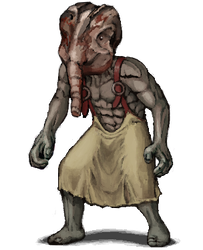
Chaugnar is one of the more unusual moonscorched forms as unlike other Moonscorched forms it doesn't seem to share much with Abella herself. Chaugnar takes the form of a Large Masculine humanoid with a Mutilated Earless Elephant head. It's skin seems almost scaley in portions, Like it's been callused. The lower half of Chaugnar is the most obvious parallel in the design. Abella lives a more masculine life for the 1940s. Due to be a mechanic she's in much better shape than many other contestants. Notably being the only Female Contestant able to use two handed weapons without issue. I've not encountered anything suggesting Abella to be insecure about her masculinity; which is a bit odd for a Moonscorched form as they tend to embody the traits the original contestant was most insecure about. Chaugnar as a name originates from H.P. Lovecraft Mythos, From a creature of the same name. However it's been confirmed the name Chaugnar is a reference in name alone due to having a similar appearance to Chaugnar from Lovecraft Mythos. So the question stands, Why does Chaugnar have an Elephant's head? Looking at Elephants from a spiritual sense they tend to represent Luck and Prosperity. Which would take on an inverted meaning as Abella is one of the first Contestants to become Moonscorched. Additionally I've seen the theory that Chaugnar's Elephant Head is due to Abella being fused with another version of the Woodsman's "Parasite" which jumps her in Tunnel 7. However Abella still becomes Chaugnar if she's in your party at the Tower or the player waits until Day 4. This could be so that she doesn't have two Moonscorched forms. Depending on how you look at it this could prove or disprove the theory.
Lore - It can't be the Parasite because Abella becomes Chaugnar when she isn't caught by one.
Development - It could be the Parasite because making an entirely new Moonscorched form just for the Tower would take a lot of extra time for an unnecessary feature.
THE GENTLEMAN (THE MAYOR); Henyrk
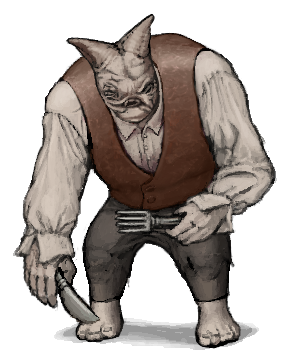
The Gentleman is one of the more straight forward Moonscorched forms. But also one of the more interesting ones. The Gentleman takes the form of a Large Guard-Esq creature which an unusual head. It's face is twisted to the point you're unable to make out it's expression at any given moment. Additionally it's eyes are so warped it's not clear if they're eyes of secondary mouths replacing them. Put simply the Gentleman is an exaugurated version of Henyrk who's lost a majority of his inhibitions. Unlike Abella it's much more clear why Henyrk Moonscorches so early on in the competition. Henyrk is prone to Paranoia and Panic as seen in the mayor's mansion on Morning 1. The Gentleman retains most of Henyrk's sensibilities but seems unattached to Henyrk's memories. This is a twisted form of how Henyrk views himself. Notably I don't believe the Gentleman to be a bad person. Unlike many other Moonscorched forms he retains an ability to reason and control himself. He won't attack the player unless they directly insult his cooking, One of the only things Henyrk seemed to value himself on. Notably it seems the Gentleman went through several phases in development which are still leftover in the game. Under certain circumstances Marina can be found in the Mayor's mansion having been kidnapped by him. Given what I've previously said about the Gentleman I doubt he would've done anything Sexually Predatory to her as Henyrk doesn't seem like the kind of person who would do something like that. However the same can not be said for the Gentleman's original appearance.
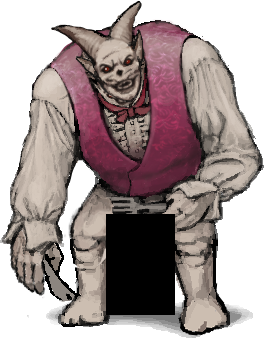
This version of the Gentleman is much more defined demonic appearance, His face showing visible malice and anger. Additionally he can be seen with a Stinger, Similar to the guards in the first game. Clearly this initial design was meant to evoke the Guards. However unlike the Guards who are animalistic, The Gentleman is cruelly aware of his disgusting deeds. I have no doubt this version of the Gentleman would have been a Sexual Predator. Given his design was changed to remove the more crass "implications" (Less Implications more outright statements), Its logical to assume the final version of the Gentleman wouldn't be as disgusting as the original. DYSMORPHIA; Samarie
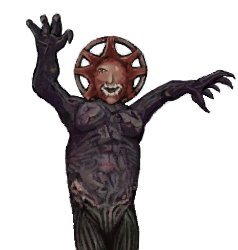
Dysmorphia takes the form of a tall black feminine creature. Her torso is notably rounded. The flesh around Her face is flayed and pulled back by a metal ring behind her head evoking the imagry of a Halo. Dysmorphia is one of the more interesting Moonscorched forms as she acts less like a monster and more like an awoken form of Samarie. She shares many of the same emotional issues and insecurities as Samarie. Dysmorphia as a name is incredibly straight forward as it refers directly to Samarie's feelings of hatred towards herself. As a recap, Samarie was apart of the Experiments in the 9th circle to contact the old gods. Her time there was torturous and awakened her ability to read minds. She feels ostracized from society and is always afraid of her imitate death due to what happened to her. Notably if she survives Termina she seems to be able to continue living just fine as she's seen to still be stalking Marina. While not explicitly stated it's possible Samarie as a form of Body Dysmorphia. Dysmorphia has a rounder stomach and torso in comparison to Samarie's stick thin body. It's hard to say if this is intentional or not due to Samarie's lack of- really anything in the game. Samarie and Dysmorphia by extension are torn between their self hatred and their need to be able to live as their true selves. As seen in their battle dialog. Player: “You were just a regular person a moment ago...” Dysmorphia: “What is that supposed to mean!? Why must everyone be regular!? Regular this! Regular that! Be normal! YOU CALL ME REGULAR!?” You managed to infuriate Dysmorphia with your persuasion efforts. (+Furious)
She's so blindsided by anyone showing any sort of kindness to her that it's enough to make her question everything she's been doing and planning for, For assumably years. Dysmorphia: “I did all this for her... I had it all ready... But then you come along...AND RUINED IT ALL!” Player: [PERSUADE] “Let's just talk this through. No harm done yet...” Dysmorphia: “Talk!? TALK!? Why would you want to talk to me!? Just look at me!” Player: “What's so weird about wanting to talk?” Dysmorphia: “...” Dysmorphia is clearly hesitating... “This is just a trick, isn't it...? You don't care about me...” (+Hesitation) I'll talk about it more in detail when I get to the Mastermind but it's also seen with Dysmorphia. Moonscorching seems less like complete monsterfication and more like an Evolution/Awakening. It's quite literally stated by Dysmorphia. Player: “What do you mean 'radiating'?”
Dysmorphia: “Like a moth! I'm finally close to bloom! A hairy moth in the night!” MONSTER; Caligura
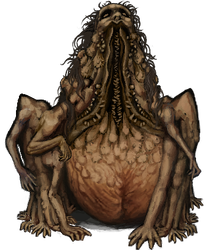
The Monster is the most straight forward Moonscorched form. It takes the form of a giant bulbus and warty combination of a Vagina and a Ball sack. This is because Caligura is a bastard. He is a ball sack before he's moonscorched and he's a ball sack after he's moonscorched. Gaining a Vagina mouth represents his lust after women. There is not much depth present in Caligura's moonscorched form. It maintains a portion of Caligura's consciousness but not much. It's only real communication ability is insults and telling the player to choke on it's balls. Semi Unrelated to Monster; One theory I've heard is that Caligura is Samarie's Bio-Dad due to how similar they look. They look even more similar when you look at Beta Caligura in comparison to Samarie.
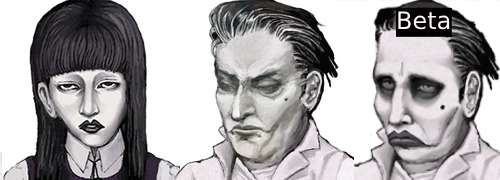
It's interesting enough to mention due to Monster's otherwise lack of subtly. WEEPING SCOPE; Levi
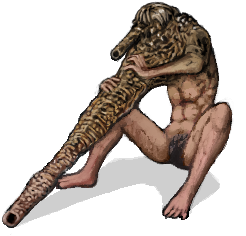
The Weeping Scope takes on a tall and semi-thin masculine form with an elongated torso. It's head has been replaced with the fleshy barrel of a tank cannon. The remains of Levi's clothes can be seen fused to it's upper torso with a notable lack of visible gentiles despite the lack of clothes. The Weeping Scope represents Levi's worst possible ending. Unlikely others like Dysmorphia and Gentleman who act as evolved forms of their contestants, Weeping Scope is Levi regressed back to his trauma and unable to escape from it. It seems to act entirely on instinct until it has a realization of what it's become. He's been turned into a weapon which can't do anything except kill. Once the player encounters the Scope for the first time it'll fire on them before fleeing. Once it flees it will hide in the Orphanage and become passive to the player unless they directly attack it. Levi is clearly still present within the Scope and still wants to be able to move on from his Trauma but is unable to escape it as he keeps getting dragged back into it. The Scope goes to the Orphanage as despite it being a location Levi was implied to have been abused in, It's the only familiar place he knows in Prehevil. Levi will never be able to fully escape the terrible circumstances of his upbringing as they'll always hang over him. -Second Reading- There's also another possible reading of the Weeping Scope which I'll mention. In this interpretation the Scope acts as an inverted version of the Cocoon. Both forms see the Contestants lose their heads in place of their most notable mutation and lose control over themselves to that mutation. The Cocoon is controlled by the Cocoon, And the Scope is controlled by it's gun. Additionally the reason no gentiles are visible on the Scope is because it doesn't have a dick, It has a Vagina which is hidden by it's pubic hair. Both the Scope and the Cocoon reveal the biggest insecurities of their contestants, Being their birth gender. This reading would make Levi trans. I think it's a valid reading even though it isn't the one I personally ascribe to. The main points against it can be handwaved. That main problem being, Levi was a Child Soldier long before women were allowed to fight in a war. Transphobia exists in the Fear and Hunger universe so it's unlikely they would let it slide. However it's also possible that they didn't care about gender in the slightest so long as they could use a gun and kill the enemy. POCKET CAT; Daan

We all know and [HAVE EMOTIONS PERTAINING TO] Pocket Cat. He's unusual because not only is he special he probably isn't a moonscorched form. He possesses Daan no matter what, The moon's radiation just speeds up the processes. Daan has without question the most cruel backstory in the series. It's almost a guarantee that his life was tampered with by outside forces. To put it simply, Daan was groomed into becoming Pocket Cat. Daan's blank soul definitely makes it easier (A blank soul may even be a requirement for possession) for him to become possessed by Pocket Cat. It's hard to say for certain how Possession works in Funger given we only really see it happen once. In lue of any deeper analysis on the meaning of Daan becoming Pocket Cat, I'd like to bring up something you may not know about. The Pocket Cat Room. If you bring a Joy Mask to the Man under the lamp post you're able to gain access to the Pocket Cat Room. The Pocket Cat Room will change depending on if Daan has been possessed or not. Here are the rooms pre and post possession.
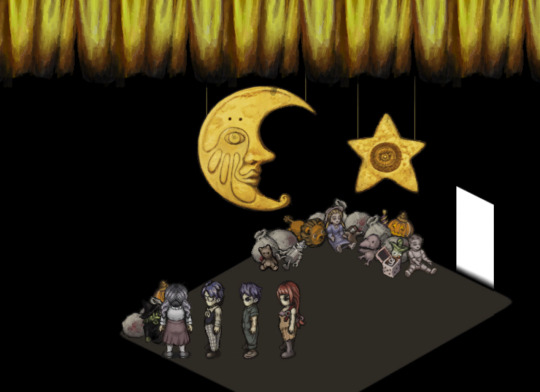
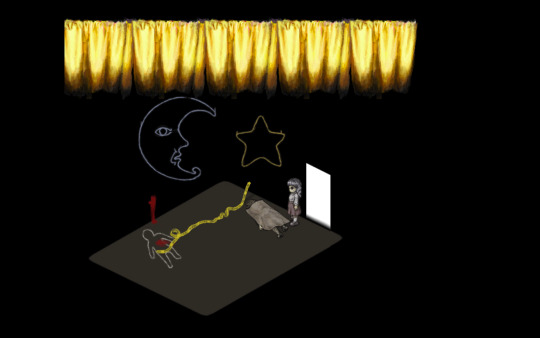
It requires contest of both to fully make sense. In the original room it's been filled up with toys and bags. These are obvious metaphors for Pocket Cat's crimes. Every time we see him with a bag there's a child inside. Each of these bags likely hides a body inside. The way this is presented, Each time a new Pocket Cat is created the slate is wiped clean as they've yet to commit any atrocities. Meaning Pocket Cat as an entity is able to escape any sort of "Karmic Punishment" is the best term I can think to describe it. As seen in Daan's room the outlines of the Sun and Star and still present as he has yet to fully delve into Rher Worship. The body seen within Daan's room likely represent the Baron and Elise. The empty chalk outline could represent how the Baron was able to get up and become Needles. Or it could represent how Elise was daan's only concern in that moment as aside from the blood and police tape the room is blank. If we were encounter another Pocket Cat room in the future while Daan is still pocket cat (Probably won't happen), We'd likely see this room become morphed to fit the original being filled up with more sacks and toys and Pocket Cat's influence becomes deeper. THE MECHANICAL DANCE; Olivia
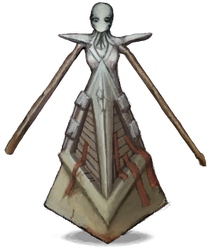
The Mechanical Dance is a weird one as it's both straight forward and mysterious at the same time. The Mechanical Dance takes the form of a Large metal pyramid with fan slots on it's sides. Attached at the top is a feminine torso in a suit with pauldrons of some sort and long stick arms. The face is completely blank aside from it's eyes. The entirety of the Dance seems to be made out of Metal. The most obvious part is that the Dance has lost it's legs entirely only being able to move via it's pyramid base. Representing Olivia being bound to a wheelchair due to her weak legs. That however is where the most obvious aspects end. Her being apart of the Dance makes some degree of sense as it could be reasons as Olivia wanting to be able to do something she can't usually do. It's hard (but not impossible) to Dance in a wheelchair. It seems the Dance's mannequin like appearance is there to draw attention away from the Humanoid aspects of it and draw attention to the Pyramid. This represents Olivia's fears/insecurities of being unable to escape the shadow of both Relia and her disability. So the Dance itself is secondary to it's mode of transport. Overall, One of the weirdest Moonscorched forms. GIANT; Marcoh
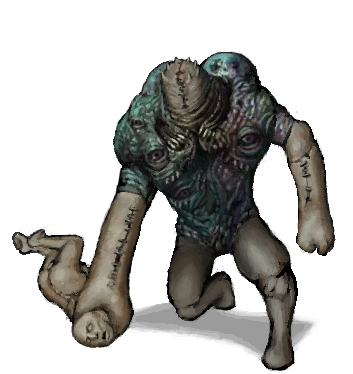
The Giant is another of the more straight forward Moonscorched forms. It takes the form of a large hulking creature with a strange warped black torso covered in eyes and teeth. It's head is comparable to that of a barnacle's tongue. Marcoh's personality is nearly completely absent from the Giant as it's only able to say "GUILTY!". It represents Marcoh's bad ending in which he becomes a brutish monster unable to think and which only acts in Violence. it's singular dialog line suggest the Giant believes everything it's doing is for the great good. However it's hard to say for sure. VALKYRIE; Karin
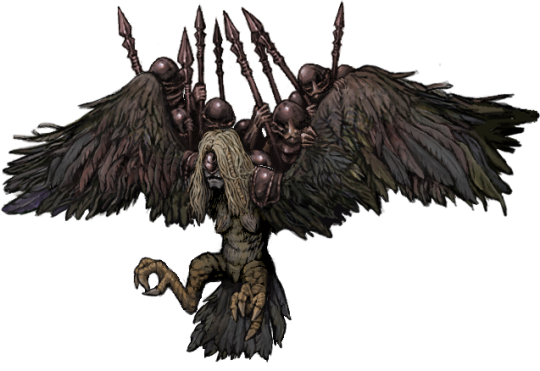
The Valkyrie is a peak moonscorch as it perfect encompasses Karin as a character and her flaws. The Valkyrie which opposite to it's name takes the form of a large Harpie with thick blonde hair. The bases of it's wings are protected by pauldrons and it's face is covered by a metal blindfold/helmet. It carries a group of Bellend on it's back. there has been a bit of debate as to what the creatures of her back are but they're clearly Bellend.
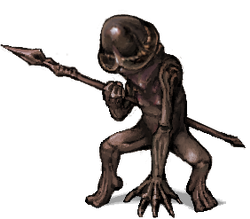
The Valkyrie's name represents Karin's own opinion of herself. In her mind she's a purveyor of truth and justice, Exposing the evils of the world and making sure those who suffer at it's hand never suffer in vein. Yet in reality her actions have acted to further ostracize the downtrodden by exposing the worst parts of their lives to the world. She's figuratively and literally blinded to the truth as she believes he's carrying lost warriors on her back to save them from death. In reality she's just bringing more Bellend to Prehevil so they can wreck havoc. From a Metaphor Standpoint, My favorite Moonscorched by far. Miro was cooking flames with Valkyrie. JUDGEMENT; Tanaka
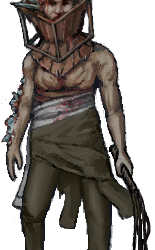
Judgement is unusual as it just seems like Tanaka fell through a window. Judgement is another Moonscorched form which acts an awoken form of the initial contestant. Tanaka as much as he's meme'd as the guy who dies first, Is actually a very strong person. As seen in his growth throughout the festival.
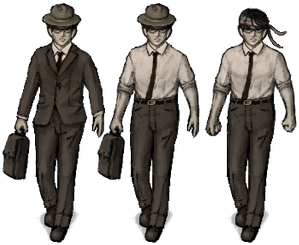
If you fight needles after Tanaka is decapitated, Needles is notably damaged. He didn't go down without a fight even this early on. Judgement is Tanaka's logical end point should he never go through his growth. Judgement represents Tanaka breaking the metaphorical Glass ceiling as seen with all the glass in his attacks and the move called "Glass ceiling". It's rather blatant. Judgement still retains Tanaka's memories as seen when you present him with the Crossword puzzle. Player: (Player has Crosswords puzzle) “That sounds familiar. Did you fill this Crosswords puzzle?” Judgement: “What of it? Back when I first arrived here, I lacked the ambition and determination. I would waste my time on this planet on the most useless of things.” Judgement has become obsessed with the Grind. Money makes the world go round and Judgement wants the sun to rise each day so he can continue to grind. COCOON; Marina
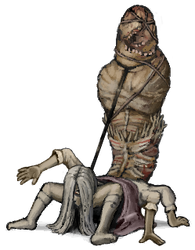
The Cocoon is Marina's body which has been bent over backwards and forced to crab walk. It's grown a second pair of arms which it uses to aid in it's mobility. A second head has grown in place of her dick which is connected by a Leash to a large Cocoon made of twisted flesh that has replaced Marina's head. The Cocoon represents Marina's traumas and fears. The Cocoon exposes her biggest secret to the world and makes it one of the only things people are able to see about her. You're only really able to see the Head, The Limbs. And the Cocoon. It's hard to tell if the Cocoon controls the body now, Or if the new head control it. Either way it represents Marina being unable to escape being lead around by her birth gender and the baggage that comes with it. I've heard the theory that the Cocoon contains Domek's corpse due to Marina being found in the church on the final day after his death. Even in death he has an inescapable control over her. The Cocoon is up there with the Valkyrie when it comes to the insight and metaphor it can give us into their respective contestants. MASTERMIND; O'saa
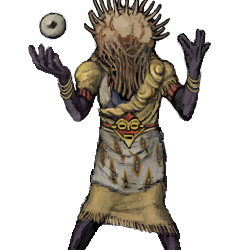
I've saved the Mastermind for last for a reason. The Mastermind without doubt is the single most unusual Moonscorched form in the game. It takes the form of O'saa with a Fungal looking growth replacing his head. a disembodied eyeball floats above it's right hand. SO WHAT THE FUCK? The mastermind more than any other moonscorch proves that moonscorching itself acts as a form of evolution. O'saa has not changed outside his appearance and now inability to speak. The Mastermind will not hunt the player down, They have to engage in battle with it. O'saa does not topple over in pain when he becomes Moonscorched like the other contestants, He sits down and meditates. Alright are you ready for my crackpot theory? Moonscorching is a form of divine enlightenment akin to the throne of ascension in mah'abre. this might sound crazy as you're probably thinking they're nothing like the New Gods we see. However I assure you, They're quite similar. New Gods aren't actually Gods in the literal sense. They're humans who have gained incredible power through the throne. However we see through the new god forms of the first game's protagonist this doesn't automatically come with a new cool form. Take Ragnavldr for example, His New God form is horrific.
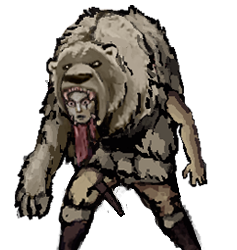
He's been hunched over and swallowed by his fur clothes which have begun to take over his entire body. It's much less gruesome than some of the Moonscorched form. But thats because everyone who can ascend in the Dungeon has gone there of their own volition. They're prepared to ascend. Aside from Samarie and O'saa, None of the contestants are at all prepared to enter a form of divine ascension. So their bodies are warped and twisted. They don't have what it takes to ascend to the next form of humanity like the New Gods. It's very possible that the Mastermind and Dysmorphia are incomplete forms of ascension which had yet to fully manifest their true selves. We fight them both soon after they moonscorch so they've had no time to grow accustomed to the green hue. Look at the normal Moonscorched people, None of them have the drive to become true Moonscorched beings like the contestants. While it's probably just for gameplay balance, Notice how we can only absorb souls from the Contestants? Their souls aren't strong enough to ascend via the green hue. Samarie and O'saa have the Radiant and Enlightened souls respectively. We know one's soul matters when it comes to moonscorching because Pocket Cat is able to possess Daan due to his Blank Soul. Rher is the trickster moon god, He doesn't want humans to ascend to godhood. However have you noticed how Rher's servants only try to stop the Girl from Ascending? True Humans can not ascend to godhood via the throne. Only Hybrid Humans can ascend to true godhood. The Girl is born of Le'Garde and Nilvan. A New god and a Human. Alll-Mer is the same. He was the son of a New god and a Human. So what if the Presence of an Old God is enough to impart a form of Divinity onto those receptive to it? The Old Gods we see in Funger 1 are only present for a single boss battle and are only traces. Yet Rher's traces are present for the entire game.
#fear and hunger#fear and hunger termina#termina#moonscorched#fear and hunger chaugnar#fear and hunger gentleman#fear and hunger dysmorphia#fear and hunger weeping scope#fear and hunger monster#fear and hunger mechanical dance#fear and hunger pocketcat#fear and hunger giant#fear and hunger valkyrie#fear and hunger cocoon#fear and hunger mastermind#fear and hunger judgement
879 notes
·
View notes
Note
Hot take: Book 2 of TLOK was not that bad of a season. It just wasn't the season it could have been.
Book 2 is really where the cracks in production started to show. The melodramatic love triangle. Characters that should have been front and center in the story getting sidelined. The fucking tribal war arc.
(That Dark Avatar arc was a hot mess and I'm tired of acting like it wasn't.)
There are moments that I thought was really interesting. Jinora was really fun and Ikki's little side story with the baby sky bison was very cute. Pema continues to be the best mom (other than Senna). Tonraq finally had his moment to put belt to ass.
(Also, Korra and her dad are the same person fr. That's his twin. She got her mom's face and complexion and Tonraq's everything else.)
Oh, B2, I love you but I hate you but I love you.
It's a genuinely interesting season to me, despite its flaws. I don't hate the additions to the lore, or the portrayal of the spirits. I think it could've used some polishing.
There's a lot I enjoy about B2, and it had potential, I think it just got a little lost in the middle there.
There's a strange theme of exploitation runniong through B2. Korra is being exploited by Unalaq, who is also exploiting the spirits. The North is occupying the South. Eska takes advantage of Bolin, who then goes on to take advantage of Ginger. Varrick exploits like...everyone, I think?
It's honestly an interesting theme and it connects well with the environmental themes we often see this the spirits. It was just... messy.
Controversial opinion; I don't...hate the Dark Avatar. I think it execution may have come off as a bit silly, but I find the concept compelling. Unalaq is an interesting character, in theory. A religious man who uses the beings he claims to revere for his own personal gain. A man who harms his family, used his already vulnerable niece in a manner paralleling sexual abuse.
While a lot of this mythology has been bastardised by popculture, Unalaq almost makes me think of certain Native American folklore elements often incorporated into modern horror. A sorcerer that commits a handful of nefarious acts, often against family, in order to gain a power and become something utterly inhuman. Acts of greed and gluttony causing a person to become a horrific, gaunt, giant monster. I'm even quite sure the latter are part of Inuit folklore, though the former originate from Navajo mythos.
I am by no means an expert, just a folklore nerd, so feel free to educate me in the reblogs lol. I also hesitate to use direct names, as I believe that is frowned upon and do not wish to offend?
20 notes
·
View notes
Text
Good morning. Season 4 finale.
Holy smokes gang. What an episode. I absolutely loved it. I think it took a little bit for me to become really invested despite the in medias res thing we had going on, but once that action started I was in it. The visuals this episode were great, I especially liked the description of the mollusk mask on the viziers face. I also was quite pleased about the little reference to hastur being the peacock king that’s fun.
I know a lot of people are sad about the butcher. I am not because as soon as he showed up again I figured he would be one of the casualties of the episode, and narratively I like that it was Kayne who did it as opposed to Larson or an unnamed cultist or alien, especially considering I had a theory that Kayne was connected to the music in his head and the powers he had. I did love the twist of him being on our side though I actually audibly reacted to that. It surprised me but made sense in the perfect way. It also makes perfect sense to not include that scene, but I am excited to see some of the fan work that comes out of that missing piece. I’m AMAZED that Charlie managed to make it out alive, but then again he might be bleeding out on a street in Spain right now. Oh well. No body no death so I’m counting him as still kicking.
Speaking of Charlie, I loved the scene where John was forced to come clean. I liked how it twisted the previous scene of Arthur speaking for John and John finally being heard by someone else and feeling so so happy, to now be forced into a position where that newfound relationship is potentially going to be destroyed because he no longer has the option of privacy. Wild.
Of all the scenes with yellow, predictably Arthur’s confrontation and apology was my favorite. He’d already admitted fault in a previous episode but this I think is where it really hit home. And in other lines, while Yellow remained adamant that he didn’t care, you could tell that he genuinely did want to understand the connection between Arthur and John, and wanted to understand why he couldn’t experience the same thing. Most tragic fragment of a nightmare king. I hope you have fun flaying Larson alive for the next couple thousand years. Also why was Larson so flirty this episode dude he killed your son stop whispering in his ear like that.
And then of course, we get to Kayne. Kayne Kayne Kayne Kayne. Glad we got confirmation that Kayne isn’t/it doesn’t matter if he’s nyarlthotep because while have a fondness for the crawling chaos and Call of Cthulhu mythos, I actually like when things are separate from that. Plus I think it makes him scarier if he can’t quantify his existence. Holding out his bloody hand for Arthur to take and Arthur choosing to go with him willingly obviously paralleling his denial of Larson earlier in the episode. I also liked his takedown of Larson a lot. Fuck that guy.
Anyway @everyone who questioned why I draw Kayne covered in blood in every scene even when he’s not fresh off a carcosan murder spree how does it feel to be wrong.
#malevolent part 40#malevolent spoilers#malevolent#again like I know it’s kinda mean to be like ‘it’s horror what did you expect’ but I’m mostly shocked MORE people didn’t die this episode
117 notes
·
View notes
Text
Headcanons and theories regarding Drosselmeyer. This also functions as personal notes for my fanfic
We know that the character’s inspired by the one from The Nutcracker story, hence his character design. The one in the story was a clockmaker, which aligns with the clocks and gears shown in the anime.
But also in the original story by ETA Hoffman, that Drosselmeyer has a cousin who’s a puppet maker. So my theory regarding the Princess Tutu universe is that perhaps the rewriting reality power is only active in one child in a generation. And the cousin’s branch created puppets for Drosselmeyer’s use as characters in his stories. That would explain Edel and why Uzura chooses to go with him in the finale.
This then brings me to Autor. Fakir’s confirmed to be Drosselmeyer’s direct descendant, which is why his stories will come true. Autor believes he’s part of a distant branch. He’s able to find the oak tree in the first place. So I believe based off my earlier paragraph, he actually is related. He’s just from a branch where the power isn’t active. And that’s why he’s able to gather so much information regarding the story.
The only other characters who realize they’re in a story are Ahiru, Fakir, and Mytho—and they’re all playing direct roles in it. Autor’s a character outside of it and he’s still able to figure out what’s happening, while everyone else in town is clueless. So this part makes me believe he does have blood ties; he’s just not from the line where the power is active.
And then I feel like it creates this nice parallel. Drosselmeyer is helped by his cousin. And Autor later helps Fakir and even fights off the Book Men for him.
15 notes
·
View notes
Text
Desert Dust & Dragon Ball Dreams: A Deep-Dive Of My New Headcanon;
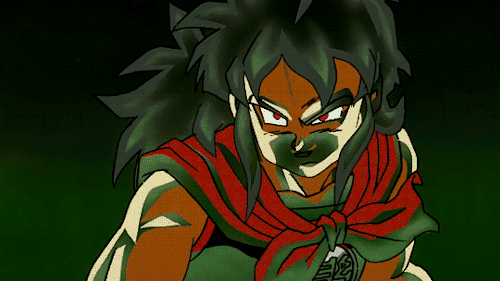
---
*“Headcanons are where fandom and imagination collide in a glorious explosion of ‘what if?’ and ‘why not?’”—Me, probably.
---
✨ Intro: The Seed of a Headcanon
From the moment I saw Yamcha stalking travelers in the blazing sands of the Diablo Desert, I felt something click. That shade of brown on his skin in *Path to Power* wasn’t just a sun-kissed tan to my younger self—it signaled an origin story begging to be told. Over years of re-watching, sketching, and daydreaming, I wove together a personal narrative: Yamcha as a bridge between two rich heritages—half Chinese, half Navajo.
This isn’t an activist manifesto, nor a declaration of *official* Dragon Ball lore. Instead, it’s my playful framework, marrying childhood nostalgia with cultural textures that resonate deeply with me.
---
🌄 Chapter One: Roots in the Middle Kingdom
* **Name & Nuance**: “Yamcha” literally means “drink tea” in Cantonese—a nod to Chinese culinary tradition. In a universe peppered with puns (Capsule Corp’s Bulma = “bloomers,” Master Roshi’s “turtle hermit” vibe), this feels *deliberate*, almost an invitation to see Yamcha as part of the East Asian mosaic.
* **Martial Arts & Mythos**: His Wolf Fang Fist, martial discipline, and wandering ronin-esque trajectory echo wuxia archetypes: lone warriors treading shifting sands, balancing honor and survival.
* **Philosophical Threads**: Beneath the bravado, I imagine him steeped in Daoist ideas—embracing yin and yang, seeking harmony in chaos. His early posture of “take what I need and vanish” mirrors the hermit sage drifting between worlds.
---
🦂 Chapter Two: Desert Winds & Diné Dreams
* **Visual Catalyst**: That scene in *Path to Power*, with Yamcha’s deep russet complexion under the midday sun, sparked my “not just a tan” theory. To me, his hue wasn’t transient—it was ancestral.
* **Why Navajo?**
* **Landscape Parallels**: The Diablo Desert’s ochre dunes & spiky cacti felt uncannily like Monument Valley vistas.
* **Wolf Symbolism**: The Diné’s bond with wolves as clan guardians resonates perfectly with Yamcha’s signature technique.
* **Survival Skills**: His desert-hardened resourcefulness—the ability to find water, set traps, read the wind—mirrors traditional Navajo teachings about living in harmony with a harsh environment.
* **Spiritual Undercurrents**: I picture him whispering traditional chants under the moon, seeking guidance from ancestral spirits, balancing his chi with the rhythms of the land.
---
🤝 Chapter Three: Collision of Cultures & Identity Crises
Being biracial in Yamcha’s world would add layers of tension and yearning:
1. **Dual Allegiances**: Torn between the stoic discipline of Chinese martial lineage and the ceremonial wisdom of Navajo elders.
2. **Outsider Syndrome**: Neither fully embraced by the desert clans nor by urban martial academies, he becomes the eternal drifter—trusted by few, admired by fewer.
3. **Fear of Connection**: His infamous stage‐fright around women? A manifestation of cultural dissonance: unspoken etiquette from two worlds, colliding and silencing him.
---
🔍 Chapter Four: Plot Holes & Self-Roast
* **No “Real” Earth**: We’re on *Dragon Ball* Earth—no USA or China flags here. So my headcanon exists in a delightful vacuum.
* **Maybe It’s Just a Tan**: I get it. But childhood logic is ruthlessly literal: if his skin looked darker, it *was* darker.
* **Canon vs. Creativity**: I’m aware that blending real-world cultures into Toriyama’s playground can feel clumsy. Yet, headcanons thrive on charming imperfections.
* **Yamcha’s True Heritage?** Could be entirely Japanese..who knows
---
🎉 Outro: Salvation for the Underdog
Yamcha never married the girl he was so much in love with, never landed the knockout punch, and became the punchline for decades of memes. In my fan-crafted universe, he’s more than a desert bandit—he’s a man woven from two proud legacies, seeking belonging. Half Chinese warrior-poet, half Diné wolf-spirit, fully underappreciated.
So here’s to Yamcha, the scrappy nomad with a heritage as blended as his fighting style—still chasing Dragon Balls, still chasing acceptance, and forever proof that headcanons are where the heart meets the horizon.
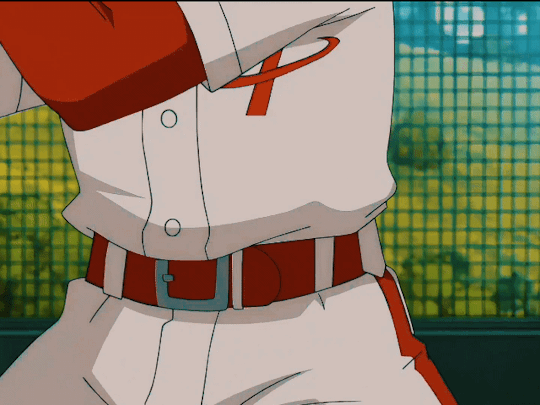
#Yamcha#yamcha db#dragonball#FandomMusings#MixedRaceFantasy#NativeAmericanHeadcanon#WuxiaVibes#DesertNomad#UnderappreciatedHeroes
10 notes
·
View notes
Text

Odyssey by Stephen Fry
The last in Fry’s four-book retelling of the Greek myths is relatable and full of humour
Not long ago, Elon Musk took a break from predicting civil war to offer his followers on X a book recommendation. “Can’t recommend the Iliad enough!” he tweeted. “Best as Penguin audiobook on 1.25 speed.” He accompanied this with a screenshot of the Penguin edition of The Odyssey. Erich Auerbach, thou shouldst be living at this hour.
Still, one way or another, Homer’s great poems have fulfilled the injunction to be news that stays news. Scholars of the original Greek, or partisans of Emily Wilson’s acclaimed recent verse translations, might roll their eyes at the injunction to speed-listen to an audiobook version. But one of the great virtues of myth is that it is robust to being reimagined: The Odyssey gives us Ulysses in one direction, and The Wind in the Willows or Watership Down in another.
And for practically as long as we’ve had the written word, we’ve had simplified retellings of the classical myths suitable for children and tech billionaires. Stephen Fry’s chatty and urbane but slyly erudite prose retellings fit right into this tradition. His Odyssey – which was preceded by Mythos, Heroes and Troy – brings a four-book sequence satisfyingly to a close.
Stylistically, Fry mostly eschews epic grandeur for the immediacy and relatability of modern idiom. The tone is spry rather than stately, and full of humour. Cassandra – wailing fruitlessly in the background all the way from Troy – is largely played for laughs; and when Agamemnon finally makes it home, the King of Men sounds for all the world like a red-trousered bon vivant back from the golf club after a bit too long at the 19th hole:
“Well, well, well! My darling, you grow ever more beautiful. The treasure ships are not far behind. The things you see! […] What’s that you say? A bath? Oh, my dear darling wife, there is only one thing I have been looking forward to more. And that can follow the bath, eh, eh?! Or maybe can be included in the bath, what?”
If he’d listened to Cassandra, he’d know what was included in the bath, but hey-ho.
Nor, though, does Fry altogether ignore the story’s pathos and poetry. There’s moving material about the easy love between father and sons – Odysseus is pierced at having missed out on Telemachus’s childhood – and here and there Fry’s default whimsy gives way to graver passages of writing. “A salt-caked, sun-burned, wind-scoured man lies face-down and naked on a beach. Sandflies skip on the scarred skin of his back.” Penelope, waiting on Ithaca, “strained her eyes towards the bar of haze that separated the blue of the empty sea from the blue of the empty sky”.
It’s not quite, or not only, a children’s book. The language gets fruity here and there – when Odysseus reveals himself to the suitors, he sounds positively Tarantinoesque: “He asked me who the hell I thought I was. I’ll tell you who I think I am. I think I am Odysseus of Ithaca, come back from the dead to revenge myself upon you. You fucking animals.” And the sexual violence is, if downplayed, not entirely absent (though perhaps to avoid muddying the moral clarity of the story for his younger readers, Fry omits Telemachus’s massacre of the maidservants).
There’s a lot of action in the footnotes, where Fry discusses lexicology or pronunciation, digresses on modern parallels, editorialises, or floats pet theories. He notes that Odysseus’s arrival on the Phaeacian coastline on a plank of his shattered raft may be “the first ever description of surfing in all literature”. He muses on why Hera is always “cow-eyed”, and notes that “cows (to us) are rarely imperious in aspect in the way Hera manifestly was, but perhaps this is a failure of observation on our part”. He argues, with reference to Beatrix Potter’s The Tale of the Flopsy Bunnies and the name of the island Cos, that the lotus eaters are actually munching lettuce. He has Athena accusing Zeus of planning to “usher in an age without treaties, promises, honour or law”, and adds in a glum footnote: “A plan that finally has come into being in every detail it would seem … ”
This is a book with a theory, too. It completes a historic arc that has taken us from gods and titans, through demigod heroes, to the deeds of mortals in whose affairs the gods meddle freely – and it points to an era in which men, in a substantially disenchanted world, will find their own way. The trial of Orestes, in Fry’s account, is something like the thematic heart of the book. In it, Princess Erigone argues for ���a new order” where “we are to reconstitute the world according to reason and sense, rather than impulse and bloodlust”, and the wise Athena “is the only god we need”. How’s that working out? Ask Elon Musk, I guess.
Daily inspiration. Discover more photos at Just for Books…?
25 notes
·
View notes
Text
Danny Phantom A Glitch in Time and the concept of ¨Tikkun Olam¨

A few days ago i was talking to my friend @chestfullofnuttycream about Furiossa's A Glitch in Time theory about how the Ghost Zone could be result of the equivalent of a nuclear wasteland. While we were commenting on it she brought up the concept of ¨Tikkun Olam¨, which comes from jewish culture and how that could apply to A Glitch in Time. (For context she is jewish).
I got curious and decided to look more into it and see how it could tie with A Glitch in Time themes and lore. In this post i'm going to discuss the term and compare it to what happens in the Danny Phantom graphic novel. For that i'm going to cite this article that describes where the concept comes from and what it means nowadays.
*On note, i'm not jewish myself. There is likely some stuff that i could be wrong or innacurate, so feel free to comment or correct me about it.
Let's start with the mythos of ¨Tikkun Olam¨:
In reference to individual acts of repair, the phrase “tikkun olam” figures prominently in the Lurianic account of creation and its implications: God contracted the divine self to make room for creation. Divine light became contained in special vessels, or kelim, some of which shattered and scattered. While most of the light returned to its divine source, some light attached itself to the broken shards. These shards constitute evil and are the basis for the material world; their trapped sparks of light give them power.
So here already we see some parallels between the mythos and Ghost Zone's origins: The spirit and human-material world used to be one, until there was a great war that lead to the separation of the two worlds and thus with Earth getting ¨shattered¨.
¨All worlds were one, all beings were one, until disharmony struck. Life and chaos amounted to war, such as never has been seen before¨ ¨The toll became too much to bear, and the great divide occured, Spirit was separated from Earth, and one world became two¨.
As the legend explains, this divide isn't meant to be the ¨natural order¨. The current state of both dimensions is wrong. The world itself as its is broken.


While contemporary activists also use the term “tikkun olam” to refer to acts of repair by human beings, they do not necessarily believe in or have a familiarity with the term’s cosmological associations. Their emphasis is on acts of social responsibility, not the larger realm of sacred acts — and on fixing, not undoing, the world as we know it. <> The phrase “tikkun olam” remains connected with human responsibility for fixing what is wrong with the world. <> Contemporary usage of the phrase shares with the rabbinic concept of “mipnei tikkun ha-olam” a concern with public policy and societal change, and with the kabbalistic notion of “tikkun” the idea that the world is profoundly broken and can be fixed only by human activity.
Tikkun Olam is a term that has changed quite a lot since its origins through out history, it can have different meanings depending on the person. In current times a lot prefer to use it as a call to do acts that can help other people or fix the issues one can find in society. In this context the world is broken and it can be fixed through people's acts in different ways.

After Danny learns about this ancient history of the Ghost World, he says that he wants to make his new emotional drive to be fixing this divide between the two worlds. He wants to find a way to fix what is wrong with this world-perhaps returning to something like it used to be.

So what this would probably involve is Danny trying to find a way that ghosts and humans can coexist together again. He would try to find a way that can work together and not having to fight each other- like helping ghosts or showing humans that ghosts aren't their enemies.
Another thing that is worth of pointing out is that Gabriela has indirectly confirmed that she was inspired by Steven Universe in her reblog from Furiossa's post. Steven Universe's creator, Rebecca Sugar, is jewish and she has been open about her jewish heritage in the past.
Some people have talked about how Steven Universe is inspired by jewish culture elements for its narrative- one of these elements being Tikkun Olam- In Steven Universe the world and the people are presented as broken and it is something that the characters try to come together to fix it in different ways- Steven himself tries to find ways to repair the damage left by her mother's legacy, Rose Quartz, which gets explored through the show.

It is possible that Gabriela was inspired by these themes that were in Steven Universe and decided apply them to write A Glitch in Time lore and story.
Now i don't know if Gabriela herself is jewish- i haven't found much indication about this so i can't fully confirm. Another possibility is that she learned about this term and was inspired by it to somewhat apply them in A Glitch in Time.
But it could also be a case of pure coincidence because she happened to take inspiration from Steven Universe- thus ¨accidentally¨ writing a narrative that can be interpreted as taking elements from Tikkun Olam and jewish culture as a whole.
Whatever it is, it is still interesting to see that this is one reading that one can do of A Glitch in Time and see how certain things take inspiration from others. I'm curious to see how this theme is going to be contuined in the next novel along with learning more about how the two worlds became separated and Danny acting as a bridge between humans and ghosts.
#danny fenton#danny phantom a glitch in time#dp theory#dp agit#jewish culture#author of the post is non jewish#save
24 notes
·
View notes
Text
On Yin-Yang, Chaos/Order, and the Harbringer
-As with many of my LMK-related posts, this is just grouchy old Ryin nitpicking. If it entertains you or gives you ideas, wonderful. If it doesn't, feel free to ignore me.
-I don't understand why LMK fan theories try to fit the square peg of Yin-Yang into the round hole of Chaos/Order divide so often. Is it because Yang is associated with Creation/Life, and Yin is associated with Destruction/Death, and if something is destructive, it has to be chaotic?
-Except mythos-wise, the Underworld is as Yin-aligned as you can get, yet they are a judicial bureaucracy and the enforcer of karmic laws.
-They are subordinate to Heaven, feared by mortals, and a grim bunch overall, but also as "lawful" as their living and divine counterparts. Like, one of the things Yin is associated with traditionally is Punishment & Executions, usually happening in the context of laws.
-Instead of Chaos/Order, Yin-Yang is more like two sets of parallel yet inseparable orders, the boundary between them is quite thin and easily crossed, and when one peaks, it soon declines and transforms into the other.
-Basically, shadow and light without the "Good vs. Evil" connotations.
-But alright, if we have to fit the square peg into the round hole for funsies: won't Yang fit Chaos more? Specifically, the chaos that accompany active creation and unprecedented change and spontaneous life, as opposed to Yin's passive maintainence, decline and orderly march towards an inevitable end?
-Like, the Thunder trigram, Zhen, is Yang-aligned despite being made of one Yang and two Yin, because it symbolizes the bottom Yang forcefully breaking through the Yin and creating a huge thunderclap.

-Here, Yang is creation via violent destruction of its opposites. Same for Fire/Li——another Yang-aligned thing that is nonetheless capable of as much destruction (burning) as creation (heat and light).
-Instead of Pure Yang being Pure Creation, and Pure Yin being Pure Destruction: I'd prefer it more if both polarities, at their highest concentration and strength, is equally creative and destructive.
-Pure Yang is a supernova explosion, an intense spike of scorching light and heat that burns itself out quickly and transforms into its opposite in the ensuing decline.
-Pure Yin is the complete decomposition of a cadaver into its respective chemicals——a gross and grim process, yet it also attracts and sustains countless other lives that feed on the products of death, and is a vital part of the cycle of life.
-It'll be more interesting to me if the Harbringer of Chaos is not a force of Yin——which is all about passivity and "keep on keeping on" and, at its extreme, stagnation, but wild, unrestrainted Yang.
-Really just, disentangle all that boring moral assumptions from Yin-Yang, and show that they are more akin to two different chemical reactions, that either extremes are rare and usually not the most effective or desirable, and whatever good or bad you can do with them, it's on you and not the powers' alignment with Yin or Yang, y'know?
36 notes
·
View notes
Text
𝐍𝐀𝐑𝐅𝐈 & 𝐕𝐀𝐋𝐈 , 𝐒𝐎𝐍𝐒 𝐎𝐅 𝐋𝐎𝐊𝐈
It’s clear that Hel will one day appear in future releases, as hinted in both GOW(2018) and GOWR, but anyone who is a myth enthusiast knows that Loki had other children besides his monstrous offspring in Norse Mythology because interestingly enough, GOW’s wiki community decided to include "Narfi & Váli" despite no evidence of their existence whatsoever throughout the Norse era.

Of course, it’s also a fandom site; while they can be a reliable source, said sources on their encyclopedia are sometimes inaccurate. Knowing the impossibility of their existence, I also thought about how they can coexist throughout GOW.
EDIT UPDATE 2/1/2024: Recently, the GOW's wiki community updated Atreus' "uncertain future" category and the links to Váli's & Narfi's wiki pages no longer existed. Doesn't mean it'll stop me from enjoying my fun. 😎🔥💯
EDIT UPDATE 7/22/2024: Nevermind, they're mentioned on Angrboða's wiki page for some reason…Váli & Narfi aren't the same as Fenrir & Jörmungandr ☝️🤓 but okay. ☠
And the more I thought about it, the more apparent it became that they’re essential for the franchise…but it’s more like my personal headcanon rather than my “crack” theory so might as well call this an AU for shits and giggles. I thought it would be fun to share my overly long detailed analysis with those who are fixated on Atreus’ other (im)possible children as much as I am because I need this to get it out of my system since they have been living rent-free in my head for almost a year just now. This blog is now officially a Narfi & Váli stan account and Kratos would have LOVED his grandsons if they ever appeared in GOW, but it's very unlikely that would happen. This analyis is going to be a long one so bear with me!
I think it would be poetic for GOW to end off including Narfi & Váli (alongside Atreus) for the final conclusion of the franchise; and yes, Hel would be an adult in this timeskip, contrary to popular belief that they were children in Norse Mythology. Despite their unfortunate demise, their backgrounds are nothing like their half-siblings’ in the Norse Mythos, making them the most ordinary of all Loki’s children. But you know what? The concept of Narfi & Váli being the epitome of normality of all Loki’s offspring gave me an a idea...I’m not sure if anyone has noticed, but Narfi & Váli exhibit some similarities to Kratos & Deimos.
Before the Olympians (Athena & Ares) pursued one of the brothers due to a doomsday prophecy, Kratos & Deimos believed they were mere mortals during childhood as they still fit the epitome of normality as children, similarly to Narfi & Váli. They’re also gods at birth, but the only difference is that Narfi & Váli most likely knew about their divine nature, whereas Kratos (excluding Deimos) only discovered it later in adulthood (a silly parallel, but I still think it counts).
Another example would be in the parallel dynamics of Váli & Kratos, as they both had experiences where they succumbed to their primal instincts in different circumstances; Váli unwillingly turned into a wolf and killed his brother driven by primal instincts under the Æsir’s (or presumably Odin’s) influence, almost similar to how Kratos was deceived and unaware, killed his first wife and daughter fueled by his primal desire for blood under Ares’ influence. While Váli’s fate remains unknown after Loki's Punishment, we can infer that both Váli & Kratos are the only survivors other than their brother.
While the deaths of Narfi & Deimos are an obvious parallel, they're also linked to Bounds and Punishment in distinct ways; like Váli, Narfi was punished with his entrails used as bounds in retribution against his father, as well as due to his relation with Loki while Deimos, on the other hand, was bound and punished due to his existence as the "Marked Warrior" (same thing goes with Kratos since he too was also bound and punished at one point in Ascension).
On top of that, they were also subjected to violence as children inflicted by Gods. Consequently, it ultimately led the downfall of both Æsir & Olympians, as predicted by their prophecy. The prophecy of the "Marked Warrior" bringing destruction upon Olympus began the moment they abducted Deimos. The sufferings of Kratos' family (including Sparta and Pandora) at the hands of Gods contributes the downfall of Olympus. Their tragedies are the major cause of Kratos' justified vengeance to destroy the entire pantheon, ultimately leading the devastation of the Greek world.
In Norse Mythology (with my limited knowledge); the Æsir's (mostly Odin's) retaliation on Loki's monstrous children, particularly Fenrir, due to prophecies contributes their downfall in Ragnarök, especially with their involvement in Loki's Punishment. However, I believe that the suffering of Narfi & Váli at the hands of Æsir Gods is the primary cause for Loki's justified desire for vengeance. The Æsir's use of Narfi's entrails, his own son, as restraints adds insult to injury, intensifying Loki's anger. Obviously, Loki joined forces with those against Æsir Gods with his army of Hel's people while the events of Ragnarök lead the devastation throughout the lands.
But since this is GOW, I found this YouTube comment (which I've kept for quite some time) that perfectly said my thoughts out loud:
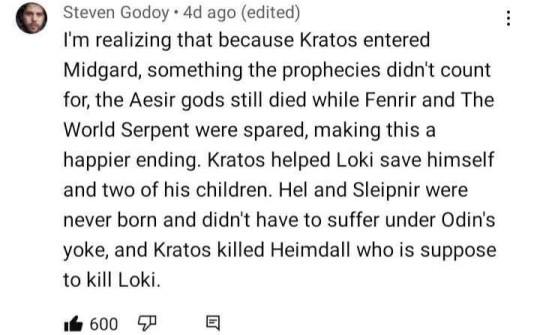
With the absence of Loki's Punishment; not only Kratos saved Narfi & Váli from Æsir's (particularly Odin's) wrath, he also prevented a similar tragedy that would inflict upon his grandsons the same way that Gods once inflicted upon him and Deimos as children, in which, fits the overall theme of subverting prophecies in GOWR.
𝐍𝐀𝐌𝐄 𝐒𝐔𝐆𝐆𝐄𝐒𝐓𝐈𝐎𝐍
Santa Monica could have easily had Atreus name his sons "Narfi & Váli" as everyone expected from Norse Mythology. But given Santa Monica's innovative approach to myth characters through creative liberties, using "Narfi & Váli" wouldn't work within the narrative structure of GOW's distinct retelling of Folklore, especially the Prose Edda of all settings.
From what I've heard, there has been a debate about whether "Váli" is a son of Odin or Loki, or both Valis existed as sperate characters. Additionally, in GOWR, there's already a boss character named Vali (The Oath Guard), which I assumed (correct me if I'm wrong) it's a cultural practice for parents to name their child after a Norse figure in Scandinavian countries, but I find it unlikely for Atreus to name one of his children after an Æsir or any God in general. Similarly, Narfi shares a name with another Giant unrelated to Loki whatsoever...but given the wide variety of Gods and other myth characters we've seen from Greek Mythology depicted in GOW, it wouldn't be surprising if other Narfi, and particularly, Váli Odinson were to mentioned or featured in future releases.
If you're not aware or need a reminder, Atreus gets to learn about Deimos during "Animal Instincts" side quest. Whether you choose to bring Atreus or Freya doesn't matter, it doesn't change the fact that Santa Monica had intended for Atreus to know about his uncle, it's still canon either way.
Atreus' identity has roots that go beyond his Norse counterpart (both symbolically and narrative wise along with the origins of his Greek name) and very likely that Santa Monica would take a similar approach with "Hel" in future releases (I've seen people suggest her name could be Faye/Laufey or Calliope, or even Callisto or Angrboða's mother). It's only fair that "Narfi & Váli" should get the same treatment…so imagine how moving it would be if Atreus were to name his sons after Kratos & Deimos.
"Váli" 𝐊𝐑𝐀𝐓𝐎𝐒 𝐈𝐈, named after his grandfather, transformed from a monster into a benevolent God due to his ability to change and open his heart, representing the beacon of hope...and "Narfi" 𝐃𝐄𝐈𝐌𝐎𝐒 𝐈𝐈, named after his great uncle, whom Atreus had known but never met (but wishes they had), honored his uncle by naming his youngest son after him.
EDIT UPDATE 3/7/2024: Just recently discovered in Greek Culture, it's common for children to be named after their grandparents, in which, aligns with my case for "Váli" to be named after his grandfather! While "Narfi" is named after his great-uncle, I believe (correct me if I'm wrong) the naming tradition also involves material/paternal relatives, which is fitting within the context of GOW. ^^
There are hearsay, or statements from Cory Barlog, that Kratos couldn't bring himself to name his son after his brother due to past memories…Atreus, on the other hand, seems open to the idea of naming one of his own children after his uncle he never met.
𝐍𝐀𝐑𝐅𝐈 & 𝐍𝐀𝐑𝐈/𝐓𝐇𝐄 𝐌𝐈𝐒𝐓𝐑𝐀𝐍𝐒𝐋𝐀𝐓𝐈𝐎𝐍
Besides Narfi Lokison and other Narfi, their accounts become somewhat unclear when Narfi's brother is addressed as "Nari." This time, it's Narfi who turns into a wolf and kills Nari. However, some sources later changed Narfi's name to Váli, both in historical texts and modern media...



EDIT UPDATE 7/21/2024: Initially, I thought this version was made based on the notion that Váli was Odin's son rather than Loki's. But after some further investigation, I'm inclined to believe that Váli is a singular character while Narfi & Nari are Loki's sons. It's also possible that "Narfi/Nari" is referred as the same character, as the belief that Váli is Loki's son is a common mistake in today's media. It would have been so easy to overlook the mistranslation and go along with the usual understanding of "Narfi & Váli"…but thinking about it now, this could actually work within the narrative structure as prophecies are ambiguously depicted in GOWR.
How about this: "Váli & Narfi" (or "Narfi & Nari") can shapeshift into wolves. Not only it emphasizes their connection with Atreus/Loki, but as a reflection of Kratos & Deimos through Speki & Svanna.
EDIT UPDATE 7/26/2024: This might be a overreach...but if Kratos' presumption that Speki & Svanna were boys did reflect something, then it could be described as a projection of his experiences as a military general as well as an extension of subconscious affection. For Kratos' case, people form stronger bonds with animals than with human (and Gods) since often times they can be deceitful/malicious, conceited, narrow-minded, backstabbing, or calculatively manipulative through obligations/false promises while animals (wolves) would instead be much more pragmatic about survival and tender care.
Speki & Svanna (+Fenrir) have been usefully vigilant and reliable wolves that aid him and Atreus, and given the history of humans surviving in collaboration with animals, there is precedence for Kratos subconsciously associating the wolves with memories of Spartan warriors he had by his side almost as though they were his own family, where survival relied on the coordination of his armies and the care given to ensuring that his men were left standing after battle.
This can very easily be associated in the mind as symbolic of a dedicated and responsible soldier as a result from a pivotally formative part of his life revolved around the Sparta's military…and out of remorse (for the casualties of people under his care amidst the war he's wrought) and love (for those who've either perished or lived as well as the people who stood by him), it felt plausible that he could've associated this with Speki & Svanna (shout out to my irl friend for cooking this up!).
Regardless, I can also imagine this as a foreshadow of Kratos' doting relationship with his future grandsons!
𝐅𝐈𝐍𝐀𝐋 𝐂𝐎𝐍𝐂𝐋𝐔𝐒𝐈𝐎𝐍
EDIT UPDATE 7/21/2024: As much as I adore the relationship between Kratos and his grandsons, I personally think it would be better if they never met in person (rest assured, Hel is fortunate enough to know their grandfather as a child). As I mentioned before, Narfi & Váli should appear by the end of the franchise, and what better way to conclude Kratos' journey than being remembered as the benevolent God even after his death?
Kratos once quoted, "Death can have me, when it earns me" might foreshadow his potential death for the final installment. Given that Kratos had "died" in previous games and even evaded his predicted "death" in GOWR, I think it would be flitting to conclude his journey if the franchise comes to an end (in which, would have opted Atreus to name one of his sons after their grandfather). But it's just a personal theory of mine, so I digress.
Narfi & Váli serves as character foils for Kratos & Deimos, illustrating their childhood origins from Ghost of Sparta to the narrative's conclusion with Narfi & Váli emerging at the end. With wisdom gained from experiences and mistakes, Atreus, aged with greying hair, gazes at his sons and feels as if his father and uncle are reunited once again…relieving their childhood they never had as children.
If you made it this far, then congratulations! Here's a quick (and old) sketch of my variant of Váli would look like:
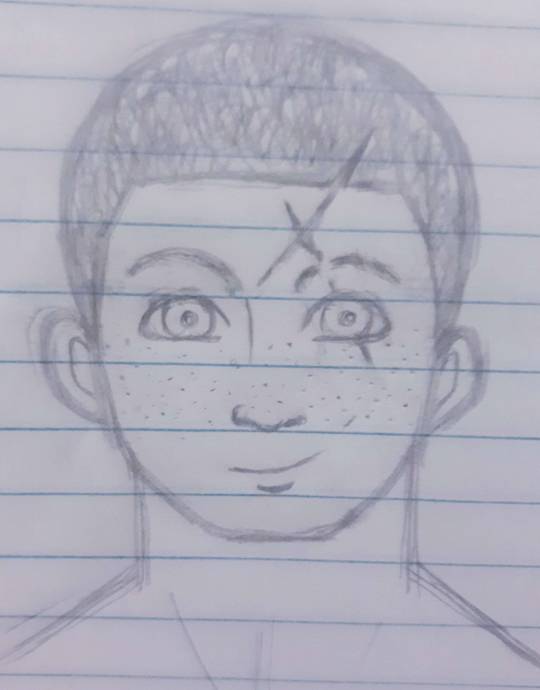

EDIT UPDATE 12/19/2024: Tried my best to replicate his facial structure. He's basically Kratos 2.0 with a decent childhood who smiles a lot more than his grandfather ever did in Sparta (he also has his grandfather's eyes and freckles from his father). Narfi, on the other hand, looks a lot more like his father with the iconic mark as a homage. They're basically Yuki & Ame (+Atreus w/Hana) from Wolf Children (I never watch the movie, but it's the vibes I'm get from them)! ^^
#Kratos² Lokison#Deimos² Lokison#Norse Mythology#Children of Loki#Loki's Children#Loki's Kids#Loki#Váli#Vali#Vali Lokison#Narfi#Narvi#Narvi Lokison#Narfi and Váli#Narfi and Vali#God of War#Atreus#Kratos#Deimos#GOW#gow Atreus#gow Kratos#gow Deimos#God of War: Ragnarök#God of War: Ragnarok#God of War Ragnarök#God of War Ragnarok#gow Ragnarök
76 notes
·
View notes
Note
QUESTION 🙋🏻♀️
if caleb is brought back to l&ds as a love interest, what do you theorise his myth cards to be???
"joke" answer: alluring secret ~black vow~
Serious answer: with the fallen angel imagery i get from QC i wouldn't be surprised if XYZ's is somewhat of forbidden apple adam and eve thing
if we follow the hans christian andersen theory: it's the steadfast tin soldier
My actual wish answer though and i think a handful of people already knows this, is arthurian mythos.
anyone can tell you by now that the so-called isle of avalon, arthur's supposed resting place, means isle of apples. and with the myths' more or less consistent story telling of MC being the unwitting antagonist (her whole existence can make or break something: a person, a kingdom, a planet; plus she's even The Witch character in some of them!) and some stories of arthur and morgana le fey being siblings, while in others they are not, it would nicely parallel the thing with XYZ and MC! in addition to that, arthur being dead and prophesied to come back?? hello???
21 notes
·
View notes
Text
Weird thing I suddenly remembered: Okay, so back in the very late 1990s and early 2000s, Young Me was really into Christian Eschatology. Call it the Millennium Fever, if you will, but when I was undergoing my Evangelical-stint (I got better, ex-vangelical now), I had a great interest in the end-times stuff. (I still have an interest in end-times scenarios / apocalypses / post-apocalypses, as can be guessed by my username. Fun for fiction, interesting to speculate on, and then there's the fact that I've survived many Historical Events and wish I would stop surviving so many Historical Events because I'm just so, so tired... Historical Events just need to STOP HAPPENING DAMMIT)! Well, there were certain preachers of this stuff (Jack Van Impe comes to mind) - and I read about half of the Left Behind series of books, which has a fictional account of the "Premillenial Dispensationalist" Christian-mythos End-Times theory. In this, (spelled out with an assassination-attempt on the character Nicholae Carpathia where he was actually killed, but rose from the dead possessed by Satan in the Left Behind novels), there was a popular theory based on some odd-ball, vauge-scripture that the Antichrist would "suffer a mortal wound" but come back from it. When looking at American politics and the intersection of it (watching people who point out the Trumpistans? I don't know what to call "Christians" whose Christ is Trump) from commentators on it, there are people who have been applying "rose from the dead" kind of language on Trump, in terms of how his political career should have been dead a long time ago, but keeps coming back stronger because "the libs can't keep him down" and blah, blah blah. And it's so...eerily similar? And as of now, Trump suffered an (alleged) attempt on his life, a wound to his ear. And... I don't know... it just sounds like the idea of how the Antichrist "will reign for 3 and 1/2 years and then suffer a mortal wound and then come back in glory to decieve and destroy the world." And, of course, he has the power to deceive the world and be worshipped. And Evangelicals everywhere are either not paying attention or have been trapped by his mind-magic conman mojo. Not saying that I believe in that singular Antichrist weirdness anymore, just that there are eerrie parallels to preaching I used to listen to and a bad series of books I used to read and reality and the hypocrisy / blindness of the culture that crafted the narrative in the first place.
#donald trump#antichrist#non-fatal wounds#left behind#evangelical#ex-vangelical#american politics#if I still believed in the antichrist#I would peg trump as the antichrist#he fits way too many parallels
9 notes
·
View notes
Text
Sutviprra keep on! In the jungles of Oujsoer, Ēwar’ sutviprra attracted the most attention. Though not necessarily on the top - among various predators, adapted to hunt creatures just like them, like Furazauiwod fallstalker and tropical short winged Oushikawod and Werkushinouakh raptors, or crocodile-like Ohghour’nikhnukhsurkiakh, waiting to snatch anything that comes for water, among various hazards, like poisonous or aggressive nukhnoonyynaazwas, wewariy and sur’kykakhsoowghour’, as well as competition from their close relatives - aersyrwasruz and werwaruzsywaseewar’ tropicasussas, they have to manage their resources and territory even in such abundant biome. Some keep close rivers, within engineered environments, making dams or supporting specific trees, securing a spot where they know they can get food in the specific season. While “ruling cast” of the north are organizers kaar’, in the dense jungle with complex ecology, the leading group is eeniowas - those, who’s trade is in nature, in learning variation in animals, fungi and plants and their utility. There is no outright religion, reverence is given to the elderly, to those who pass on or to the knowledgeable, there are various myth continuities with varying interaction with reality. The belief complex of Okhdeur’sur’fu’r is one taken as thruth, this is the one taught by the Eeniowas matrons - in their theory of the natural environment and its management, various superstitions and mysticism is mixed in. They believe in the tie between their families and their burial sights - nisniowekshisoow, where the dead serve as the fuel for a great garden, - and the oldest trees in the middle - Wekshinieinis, in various assumptions about animals and in the existence of monsters as if they are real. There is also a mythos, known to be an invention - the setting for children’s fairy tales, with repeating characters and tropes.
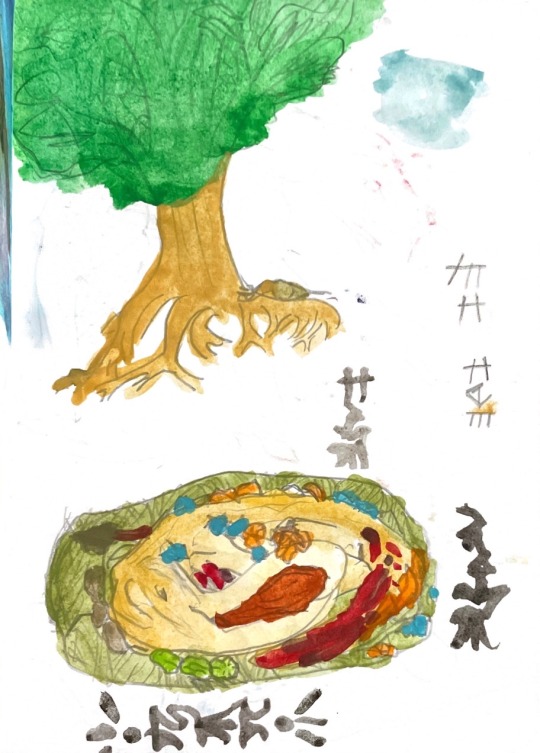
But in the jungles there is plenty of space and it’s easy to miss someone in the dense vegetation. Parallel to Ēwar’, many singular independent tribes forage of the same land. When efforts of Kaikaisurr’ were centralized, such tribes dwindled in population and lost their territory, but with fracturing of Ēwar’ they managed to restructure themself into a new culture - Ledealada. They all share the experience of being pressured out of their normal dwellings and having to explore unknown regions. Such prosecution sparked, at first, rapid development of food recourcing and weaponary, and than an allience of several tribes. This organization managed to push back against against the Ēwar’, carving out the territory in the jungle. The Ledealada people returned to their land victorious.
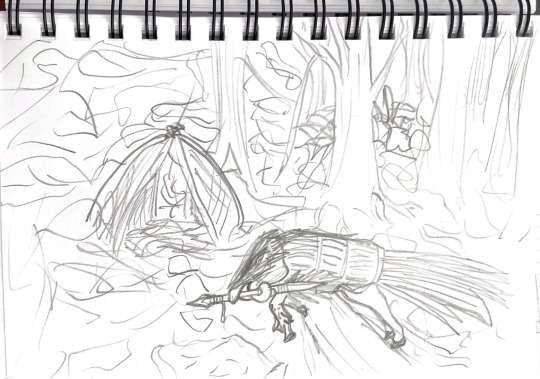
#sutviprra#art#speculative biology#worldbuilding#spec bio#alien design#exobiology#spec evo#speculative evolution#digital art#nonhuman
7 notes
·
View notes
Text
spicy meatballs SH takes Parallel worlds theory is bullshit. There is only one reality which gets overwritten by the Otherworld; Harry says as much in SH1. He faints during Otherworld shifts because reality is literally changing right before his eyes and his mind shuts down trying to process it. Furthermore, a 1999 SH1 strategy guide likens the cycle of the Otherworld to the stages of REM sleep. Full circle theory is bullshit. Silent Hill doesn't want to punish or rehabilitate people. Silent Hill doesn't want anything. Whatever you think you deserve is what you'll see. Silent Hill is also capable of giving people what they want, if only briefly. Eddie, a pizza; James, a healthy "wife"; Angela, to see her mother again. The cult calls themselves "the Organization." Outsiders call it "the Order." At this point, the "muh trauma and guilt" stuff outnumbers the cult stuff by a wide margin. It's beyond moot to complain about cult stuff. The cult is actually pretty interesting; it's just that the later games tack on nonsensical additions. Silent Hill's horror encompasses a lot more than just themes of personal trauma and guilt. Pigeonholing it into those themes over and over again does the franchise a disservice. "Samael" is some demonic-sounding bullshit Dahlia made up in order to scare Harry. It's not an actual being in the mythos except as a derogatory name the Order's opponents call their God. Silent Hill is not sentient. It merely gives people the impression that it is. SH3 deserves better than to be labeled as just "women's horror" on the basis of its pregnancy and menstruation motifs. It's also a coming-of-age tale that tackles themes of suffering, abuse, religious trauma, growing up, sin, and responsibility. SH3 would probably have been as good as SH2 had it had more time to bake in the oven. Silent Hill does not automatically lure the guilty. In fact, I could make an extremely faint case that kindness draws one to Silent Hill as well, seeing as how many of the innocents that go there do so through a combination of bad luck and kindness ex. Eileen offering Walter her doll; Harry and his wife taking Cheryl home; Douglas taking up Claudia's case to find a kidnapped girl, later compelled to help Heather It's not ash. It's snow. Kaufmann remarks that "it's snowing. This time of year." In Water was probably not the developers' intended ending; the narrative explicitly condemns suicide via James' dialogue, probably hinting at the team's own views. This is bolstered by the fact that the game's programming leans the most away from In Water whenever you start fresh on SH2, giving it the lowest initial score of the three endings.
7 notes
·
View notes
Text
Other signs Eddie may return in S5: Eddie has a lot of Jesus parallels
tw: christian religious talk
I think they could bring Eddie back and it would work beautifully with the narrative of both the show and book.
I do enjoy the Kas theory, but there are other compelling things that may point to him coming back.
I am not religious currently, but I used to very much be and some things just jump out to me: I see a lot of Jesus parallels with Eddie.
From the recent book and the show we know Eddie has been persecuted by by the town in general and in particular as part of the Satanic Panic. However, Eddie demonstrates far more moral fiber and kindness than any of those who wield a cross as a weapon against him. Now, Eddie being good and a far better than those who hate him by itself isn't a clue but when I add it to the other things I see it becomes one.
The metaphor of his 'sheepies'. This one is a big one for me because of how often Jesus is referred to as a shepherd and how many parables he gives of taking care of his sheep.
He dies willingly to save one of his sheep
When the bats get him he is spread out on the grown, not in an exact crucifixion position, but very close with his arms laid wide. He hasn't had anything in his hair until this battle started and now there is the bandana like a crown (of thorns).
The injury that is implied to kill Eddie is the bats biting on the side of his abdomen/flank. The placement is the same as the spear Longinus which was the killing wound to Jesus on the cross. A spear was also the weapon he carried.
Eddie making Dustin promise to look after the sheep is reminiscent of Jesus's talk with Peter, the rock of the church
He is literally forsaken by his father. (Father, why have you forsaken me?)
Has alternative father figure in Wayne akin to St. Joseph
Skull Rock is sort of a temptation of Jesus on the mountain in which he is asked if he wants to stay or go forward and he chooses to go forward
I need to double check this, but 3 people when asked about about Eddie/Hellfire pretend not know Eddie or be associated with Hellfire: Lucas when asked by Jason and the basketball team; Dustin, Max, and Lucas when questioned by the Sheriff in front of their parents (and Erica) after they are caught by Lover's Lake; This reminds me of Jesus being denied 3 times (even if that was 1 person for Jesus).
This is not religious symbolism but I'd like to point out that Jason foreshadowed his death with 'first hangover makes you feel like you're going to split in two'. I think Eddie foreshadows his death and resurrection when he pretends to die and fall on the ground when he meets Chrissy in the woods.
The irony of the character being hunted by zealots in the Satanic Panic being Jesus-like is so satisfying to me, particularly because I know someone who was hit by the Satanic panic and was so so much kinder of a person than any of the assholes wagging their tongues and backbiting him.
Anyway, it's been a while for the religious stuff for me but it's still in there, hope you find it interesting. I think it makes for an interesting 'Eddie gets resurrected' build up alternative to Kas. Although, with popular vampire mythos the Jesus tie works with vampire!Eddie too.
#stranger things s5 theory#eddie munson#tw christian symbolism as it relates to the show#stranger things theory#stranger things#eddie munson returns theory#my ST theories#stranger thoughts#bananas writes
4 notes
·
View notes
Text
Watch "Argonautica & Ironborn Mythos Parallels: The Mermaid Wife was a Fire Priestess | ASOIAF Theory" on YouTube
youtube
#asoiaf#game of thrones#iron islands#ironborn#grey king#mermaid wife#medea#jason#argonauts#nagga#Youtube
4 notes
·
View notes